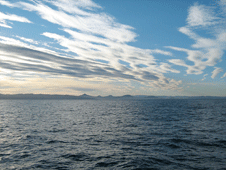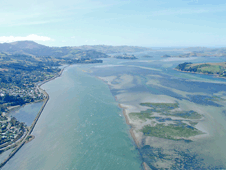 The New Zealand Marine Studies Centre and Portobello Marine Laboratory is on the Otago Harbour on the SE coast of the South Island (170° 46'E 45° 50'S), 23 km from the University's main campus in Dunedin.
The New Zealand Marine Studies Centre and Portobello Marine Laboratory is on the Otago Harbour on the SE coast of the South Island (170° 46'E 45° 50'S), 23 km from the University's main campus in Dunedin.
A wide variety of southern cool-temperate biological communities and habitats, remote from major centres of population and industrial pollution, are accessible from the Centre.
Habitats range from sheltered inlets to open waters of the continental shelf and slope.
The Subtropical Convergence, a major oceanographic boundary, is located over the outer shelf/upper slope and separates water of subtropical origin from offshore Surface Subantarctic Water. Distinct pelagic biotas characterise these water masses. Beyond the edge of the shelf, at depths greater than about 700m, is the lower salinity Antarctic Intermediate Water. The adjacent continental shelf off Otago Peninsula is relatively narrow (~10-30 km wide); the shelf break occurs at about 130 m.
Modern sedimentation is mainly confined to nearshore deposition of sand derived from the Clutha River to the south. This land-derived sand covers the inner shelf, generally to water depths of 30-50 m. The middle and outer shelf is characterised by gravelly sediments containing much relict and biogenic material. These coarser sediments support a diverse epifauna, including, at depths of 70-100 m, an abundance of bryozoans some of which locally dominate the epibenthos adding an important structural dimension to the benthic environment. Other diverse groups on the shelf include the echinoderms and crustaceans. The shelf edge off Otago Peninsula is incised by a series of submarine canyons, tributaries of the Bounty Trough; these have a diverse benthos.
 Otago Harbour is the largest of the region's marine inlets (46 km2). The Harbour is mostly very shallow such that extensive sediment flats are exposed at low water. Sandflats of the Outer Harbour support dense shellfish populations, especially of the venerid clam Austrovenus stutchburyi. Characteristic of rocky substrata in the Harbour is the large bladder kelp, Macrocystis pyrifera, which fringes much of the shoreline. Brachiopods are accessible at low-tide level.
Otago Harbour is the largest of the region's marine inlets (46 km2). The Harbour is mostly very shallow such that extensive sediment flats are exposed at low water. Sandflats of the Outer Harbour support dense shellfish populations, especially of the venerid clam Austrovenus stutchburyi. Characteristic of rocky substrata in the Harbour is the large bladder kelp, Macrocystis pyrifera, which fringes much of the shoreline. Brachiopods are accessible at low-tide level.
Otago Harbour is bounded along its southern and eastern side by the Otago Peninsula. On the ocean side of the Peninsula are a number of wave-exposed beaches and rocky shores. Rocky shores of the Peninsula's outer coast are very wave-exposed. A dominant low-tide seaweed here is the bull kelp (Durvillaea antarctica). The rocky subtidal zone of the outer coast supports a rich community of sessile invertebrates (sponges, hydroids, anemones, bryozoans, ascidians, etc).
The Otago Peninsula and adjacent waters provide excellent opportunities to view marine mammals and seabirds. Notable species include the New Zealand fur seal, Hooker's sea lion, dusky dolphin, yellow-eyed penguin, little blue penguin, cormorants and Royal albatross.